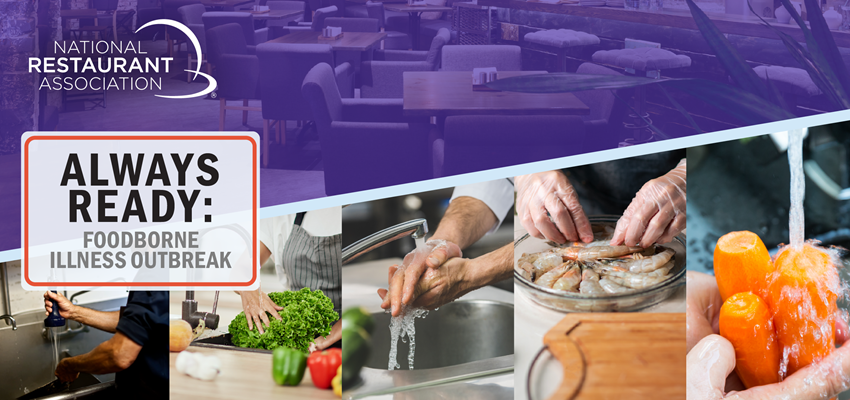Articles
August 29, 2024
How to handle a product recall in your restaurants
No one likes dealing with recalls, but they'll probably affect you at some point. Here’s a good plan of action for operators.

Consider making a checklist and/or create forms in advance of having to deal with a recall.
If you haven’t ever been impacted by a recall, now’s the time to get prepared. This article offers suggestions on how you can navigate a recall event in a way that’s least disruptive to your business while still protecting your customers and meeting regulatory requirements.
First, some terms:
Your distributor/supplier should let you know if you’ve received a supply that’s been recalled. They’ve heard from their supplier, who heard from the manufacturer, that there was a recall that needs to be passed on. However, the means of notification isn’t always perfect and information might not make its way to you. If you purchase some ingredients from the supermarket, they might not have a system to alert you if you’ve bought something that’s later recalled.
You can proactively learn about recalls by signing up for alerts. FDA, USDA FSIS and STOP all have opt-in systems. However, recalls happen daily and it can be overwhelming to keep checking to see if you have the item that’s been recalled.
If your company has more than one location but doesn’t have a corporate HQ per se, set up a system in which a recall anoticelert to one unit is conveyed to all units.
If you hear about a recall on the news, from the health department, or anyone else—and have a question about whether it impacts you—call your supplier and ask. If they’re not sure, or if you want to double check, look at the public lists of recalled items and compare it to your inventory. FDA maintains a searchable list, as does USDA FSIS (for meat, poultry, processed eggs and catfish).
What should you do if you’ve received something that's recalled?
There are 4 main things to do if you’ve received a recalled product:
Act: If you verify you’ve received a recall ingredient, it’s critical to follow the instructions for disposal provided by your vendor. Most state regulations (the majority of which are based on the FDA Model Food Code) require that a recalled product be segregated so that it doesn’t contaminate other food. Your supplier might ask you to destroy the product and provide proof of the destruction, such as photographs. Ensure that product is destroyed in a way that prevents anyone else from gaining access to it (e.g., via dumpster diving). Adding bleach to the food is one way to destroy it. In other situations, you might be asked to return the product.
Document: Regardless of the way you act on the recall, keep good records including the date of action (destruction or return), number of units, and ideally the lot numbers or other identifying information. This can help you get proper reimbursement or credit for the loss.
Communicate: If your supplier is the one who alerted you to the recall, close the loop with them. Let them know what actions you took and provide the documentation to prove it.
What else should I know?
Recalls can be a little easier to handle if you get your ingredients from distributors who have good recall systems in place for themselves. Ask them how they handle recalls, and what they expect from you. When you need to make a ‘fill in’ purchase, keep your receipts.
Consider making a checklist and/or create forms in advance of having to deal with a recall. The checklist should include the specific actions to take (e.g., find the lot number on the case; fill out the recall form, call the vendor) and identify who (which role) is responsible for carrying out the action.
Finally, don’t be alarmed if a regulator stops by to check that a recall has been carried out effectively. They want to make sure that the communication within the supply chain is effective and that you’ve taken the steps necessary to remove recalled items in order to protect your customers.
The food-safety subject matter experts at the National Restaurant Association have extensive experience in helping manage recalls. They can answer your questions and assist you during a recall process, if needed.
Contact @Patrick Guzzle for more information.
First, some terms:
- A recall is the removal of a product that is in violation of the law. This may be because it contains pathogens that can sicken people because these pathogens contain undeclared allergens that can trigger a possibly fatal allergic reaction in an unknowing consumer, or some other issue.
- Recalls are generally issued by the manufacturer. Once the manufacturer knows there’s a problem with the food, they determine how widespread the issue is. So, a recall may be of just one lot of product, or a year’s worth of production. It’s up to the recalling firm to decide and communicate that through the supply chain.
- Don’t be confused if you see that a recall is “voluntary.” IT IS NOT OPTIONAL. “Voluntary” simply means that the manufacturer is recalling the product on their own, as opposed to a regulator (such as FDA) mandating the recall. Virtually all recalls are voluntary. They still must be followed.
- A market withdrawal or stock recovery happens when the supplier decides, for whatever reason, that the product isn’t suitable for sale, often due to a quality issue. It’s a good idea to follow directions to hold or return a product subject to a market withdrawal, but it does not have the same sense of urgency as a recall. When there’s a recall, lives may be at stake. With a withdrawal, lives are not at stake.
Your distributor/supplier should let you know if you’ve received a supply that’s been recalled. They’ve heard from their supplier, who heard from the manufacturer, that there was a recall that needs to be passed on. However, the means of notification isn’t always perfect and information might not make its way to you. If you purchase some ingredients from the supermarket, they might not have a system to alert you if you’ve bought something that’s later recalled.
You can proactively learn about recalls by signing up for alerts. FDA, USDA FSIS and STOP all have opt-in systems. However, recalls happen daily and it can be overwhelming to keep checking to see if you have the item that’s been recalled.
If your company has more than one location but doesn’t have a corporate HQ per se, set up a system in which a recall anoticelert to one unit is conveyed to all units.
If you hear about a recall on the news, from the health department, or anyone else—and have a question about whether it impacts you—call your supplier and ask. If they’re not sure, or if you want to double check, look at the public lists of recalled items and compare it to your inventory. FDA maintains a searchable list, as does USDA FSIS (for meat, poultry, processed eggs and catfish).
What should you do if you’ve received something that's recalled?
There are 4 main things to do if you’ve received a recalled product:
- Check
- Act
- Document
- Communicate
Act: If you verify you’ve received a recall ingredient, it’s critical to follow the instructions for disposal provided by your vendor. Most state regulations (the majority of which are based on the FDA Model Food Code) require that a recalled product be segregated so that it doesn’t contaminate other food. Your supplier might ask you to destroy the product and provide proof of the destruction, such as photographs. Ensure that product is destroyed in a way that prevents anyone else from gaining access to it (e.g., via dumpster diving). Adding bleach to the food is one way to destroy it. In other situations, you might be asked to return the product.
Document: Regardless of the way you act on the recall, keep good records including the date of action (destruction or return), number of units, and ideally the lot numbers or other identifying information. This can help you get proper reimbursement or credit for the loss.
Communicate: If your supplier is the one who alerted you to the recall, close the loop with them. Let them know what actions you took and provide the documentation to prove it.
What else should I know?
Recalls can be a little easier to handle if you get your ingredients from distributors who have good recall systems in place for themselves. Ask them how they handle recalls, and what they expect from you. When you need to make a ‘fill in’ purchase, keep your receipts.
Consider making a checklist and/or create forms in advance of having to deal with a recall. The checklist should include the specific actions to take (e.g., find the lot number on the case; fill out the recall form, call the vendor) and identify who (which role) is responsible for carrying out the action.
Finally, don’t be alarmed if a regulator stops by to check that a recall has been carried out effectively. They want to make sure that the communication within the supply chain is effective and that you’ve taken the steps necessary to remove recalled items in order to protect your customers.
The food-safety subject matter experts at the National Restaurant Association have extensive experience in helping manage recalls. They can answer your questions and assist you during a recall process, if needed.
Contact @Patrick Guzzle for more information.
Get the report
Get the report
Sign up for our Newsletter
The latest news from the National Restaurant Association, published every other Thursday
By clicking Submit I agree to receive email communications from the National Restaurant Association and agree to our Privacy Policy(Opens in a new window).
